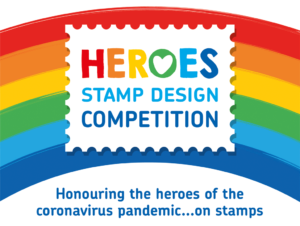“Investing” in U.S. New Issues
by John M. Hotchner
My Dad was a serious collector who knew his philatelic A, B, Cs. He loved especially U.S. and German stamps, and went so far as to make his own albums. I learned much at his knee; both things to do and things not to do. After an unhappy incident when I was 12, we came to an agreement that we would collect different countries; with one exception, which I will get to.
 The incident took place at a meeting of the New Delhi, India, Stamp Club in 1955, while he was assigned to India as the U.S. Information Agency’s liaison officer to All India Radio.
The incident took place at a meeting of the New Delhi, India, Stamp Club in 1955, while he was assigned to India as the U.S. Information Agency’s liaison officer to All India Radio.
The meeting happened to have an auction, and I had just gotten my allowance – the princely sum of 5 Rupees per week (or about $1 U.S.). Added to money I’d saved, I had about 30 Rupees burning a hole in my pocket, and when a lot of Indian “Service” overprints came up, half a dozen hands went up around the room. I was in the back, looking in the equivalent of a penny box. I joined in the fun.
As the bids passed 10 Rupees, the sport of it all took hold of me, and I was determined to get the lot. As bidders dropped out, I failed to realize until too late that I was bidding 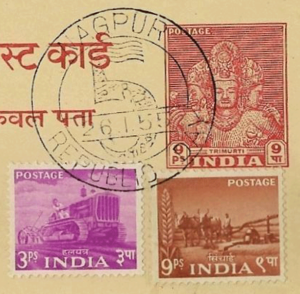 against my father. He may not have realized he was bidding against me. But when he dropped out and I got the lot, and had to announce my name and club number, the cat was out of the bag.
against my father. He may not have realized he was bidding against me. But when he dropped out and I got the lot, and had to announce my name and club number, the cat was out of the bag.
On the way home, he was characteristically quiet; as was I. I had no idea of the storm to come. He was quiet for a week, and ultimately it was my mother who told me that he was furious, and I was guilty of improper behavior. To make a long story short, that was the end of my India collection, and he and I agreed not to be competitors in the future; enforced by our splitting of our collecting interests – except for United States, which he would collect mint, and I would collect used.
As part of his collecting he had been buying several sheets of U.S. mint new issues since the end of World War II, and he continued to do so – along with a lot of other stamp collectors – as a hedge against inflation. He saw stamps from the 1920s and 1930s doing fairly well in Fine-to-Very Fine condition, and made the assum
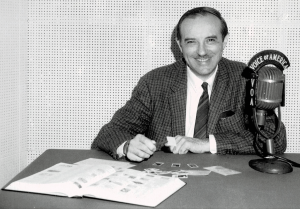
Howard Hotchner
ption that the trend would continue. So, he made an effort to put away at least a few VF panes of each new issue until he was disabled by Parkinson’s disease in the late 1980s. On his passing, I assumed his rather nice India collection, among others, and was also heir to a two-foot-high stack of U.S. mint sheets, not to mention a hefty holding of plate blocks that he had stashed away over the years.
I was not alone. It seemed that a great many collectors had the same idea post-WWII, and the Post Office Department thoughtfully upped the production runs to make certain that there would be plenty of stamps to satisfy demand.
The result was, and continues to be today, that panes of mint US commemoratives from the late 1940s onward are pretty much a drug on the market. Oh, there are a few that are “better” than face because of the subject portrayed, or because of shorter than usual production totals, but I found out to my chagrin that the holding was not going to bring even face value if sold. It was a buyers’ market as lots of other heirs had bales of mint U.S. to sell in bulk.
Luckily, I was by then writing columns for several philatelic publications, and – this being before the era of widespread use of the Internet – I had a considerable correspondence, and began to use the stamps for postage. Here it is 25 years later, and I am still using some of Dad’s hoard.
But it seems that the collector community and the heir community never connected, because collectors continue to buy and salt away panes of mint U.S. stamps. What with multiple designs in a pane, and smaller panes with fancy marginal art, a higher percentage 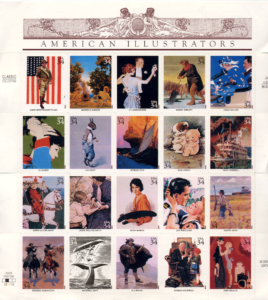 of these more modern emissions do have premium value in the secondary market. But for the original buyer trying to sell them among quantities of other mint stamps including plate blocks, booklets and coil rolls, face value is about what can be expected if one is lucky.
of these more modern emissions do have premium value in the secondary market. But for the original buyer trying to sell them among quantities of other mint stamps including plate blocks, booklets and coil rolls, face value is about what can be expected if one is lucky.
And that ain’t so good when one considers the impact of inflation, and the rise in postal rates. More often, quantities of US mint stamps sell in clubs between collectors at 80 to 85% of face. And if selling to a dealer, the offers drop off precipitously as the face values of the stamps offered decrease. In fact, I recently saw a dealer describe his business practices as follows:
“I own thousands of face value stamps in my warehouse, and rarely take any to stamp shows. Yes, if I buy for 25-40% of face depending on content and condition and sell it for 70-80% of FACE, that is a great percentage markup. In my experience, the volume of sales will not justify the table space regardless. I really am not a great buyer for postage except as part of a much larger and better collection.”
I do see dealers at shows selling U.S. mint at face from large boxes of stock. And there seem to be lots of collectors poking through the material though I don’t know how much actually sells. The point is that a dealer who has to make a profit, and pay himself for the time he or she has put into acquiring and preparing the material to sell, has to buy at 30-40% below the sale price.
Many feel that this is unfair given what they or their collector relative put into the stamps. But “fairness” really does not enter into it. Supply-and-demand is what governs. And there is far more U.S. mint material for sale than there is demand to absorb it. Just like selling stocks at a loss, sometimes you win, and sometimes you lose.
My father was not looking to get rich quick. He bought prudently, in small quantities with low amounts of money, and based on what he saw as past performance. It was not irrational to expect that 20-25 years down the road, he would reap a modest profit. But, as it turned out, he would have done better to put the same amounts into, say, used $5 Columbians, or other premium U.S. stamps.
And yet, there continue to be collectors who follow the path of investing in mint panes, booklets and coil rolls. A few dynamics make this problematic. First, though the production quantities have decreased markedly, so has the percentage of collectors in the population. Add in the facts that inflation continues to rise, and postage rates continue to rise, while mail volume has declined and will likely continue to do so.
What this means is that the Postal Service is the only guaranteed winner in this equation. They get to use the money right now that collectors pay for stamps they stockpile and don’t “redeem” for many years into the future. And make no mistake: a great many of these “old” stamps are indeed ultimately going to be used for postage.
There are several lessons here. First is that buying mint U.S. stamps in quantity as an investment strategy will likely not turn out well. Second, if you decide to sell your accumulation while you can still benefit, do not sell everything as a single lot. Do your homework, and don’t be in a hurry. Watch buy prices for thematic commemoratives, booklets, coils, etc. that have acquired some premium value. You may not make a lot more than face, but at least you will do better than the 50-60% you would be offered for a large accumulation.
Third, find ways of selling what is left to other collectors at a small discount rather than to dealers at a large discount. Being a member of a stamp club is a plus because many collectors like to use older colorful stamps on their mail.
Fourth, be grateful that you are getting something back on your investment. For most hobbies and pastimes, you are buying pleasant memories, and maybe an investment in physical fitness, but you will get nothing back on the money you have spent on event tickets, golf club entry fees, tennis balls, etc.
Fifth, unless you are a movie star or a sports hero at the professional level, there is no such thing as easy money; and even for them that spigot can be turned off in a hurry if their performance or drawing power drops off. If you want to make money you have to work for it. And in stamps that means what may seem like an easy and sensible scheme, be it in mint stamps, first day covers, plate blocks, gold-replica stamps, or foreign new issues, rarely pans out. To be a successful investor, one must study the investing alternatives, past performance, collecting trends, supply versus demand, the real liquidity of different kinds of investment alternatives, and then make informed, clear-eyed, choices that are still only educated guesses.
But all of this is work, and in some sense is incompatible with why we start a hobby in the first place – to occupy our free time with a pleasurable activity. Investing may seem like a natural extension of collecting, but it is a different level of effort if done seriously; and one that can lead to disappointment with what had been at one time a fun hobby.
Should you wish to comment on this editorial, or have questions or ideas you would like to have explored in a future column, please write to John Hotchner, VSC Contributor, P.O. Box 1125, Falls Church, VA 22041-0125, or email, putting “VSC” in the subject line.
Or comment right here.
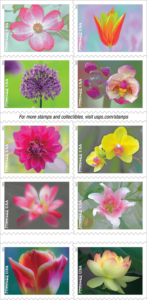 5558 (55¢) Garden Beauty – Pink Flowering Dogwood
5558 (55¢) Garden Beauty – Pink Flowering Dogwood
